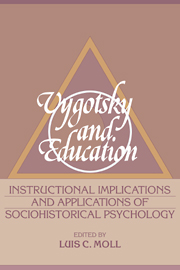Book contents
- Frontmatter
- Contents
- List of contributors
- Preface
- Acknowledgments
- Introduction
- Part I Historical and theoretical issues
- Part II Educational implications
- Part III Instructional applications
- 11 Changes in a teacher's views of interactive comprehension instruction
- 12 Learning to read and write in an inner-city setting: A longitudinal study of community change
- 13 Writing as a social process
- 14 Creating zones of possibilities: Combining social contexts for instruction
- 15 The zone of proximal development as basis for instruction
- 16 Detecting and defining science problems: A study of videomediated lessons
- 17 Assisted performance in writing instruction with learningdisabled students
- Name index
- Subject index
14 - Creating zones of possibilities: Combining social contexts for instruction
Published online by Cambridge University Press: 05 June 2012
- Frontmatter
- Contents
- List of contributors
- Preface
- Acknowledgments
- Introduction
- Part I Historical and theoretical issues
- Part II Educational implications
- Part III Instructional applications
- 11 Changes in a teacher's views of interactive comprehension instruction
- 12 Learning to read and write in an inner-city setting: A longitudinal study of community change
- 13 Writing as a social process
- 14 Creating zones of possibilities: Combining social contexts for instruction
- 15 The zone of proximal development as basis for instruction
- 16 Detecting and defining science problems: A study of videomediated lessons
- 17 Assisted performance in writing instruction with learningdisabled students
- Name index
- Subject index
Summary
Of great value, in both scientific and practical respects, would be the pedagogicalpsychological investigation of the reciprocal relation between learning activity and the productive labor that pupils undertake together with adults. This problem has received precious little attention by developmental and pedagogical psychology in the Soviet Union, although the development of learning activity is closely tied precisely to productive activity.
V. V. Davydov (1988, p. 34)One of the most interesting and important contributions of Vygotskian psychology is the proposal that human thinking must be understood in its concrete social and historical circumstances. As Luria (1982) explained it, to understand thinking one must go beyond the human organism. One must search for the origins of “conscious activity,” not in the “recesses of the human brain or in the depths of the spirit, but in the external conditions of life.” “Above all,” Luria continued, “this means that one must seek these origins in the external processes of social life, in the social and historical forms of human existence” (p. 25). He later reiterated as follows:
The basic difference between our approach and that of traditional psychology will be that we are not seeking the origins of human consciousness in the depths of the “soul” or in the independently acting mechanisms of the brain. … Rather, we are operating in an entirely different sphere – in humans' actual relationship with reality, in their social history, which is closely tied to labor and language.
(1982, p. 27)- Type
- Chapter
- Information
- Vygotsky and EducationInstructional Implications and Applications of Sociohistorical Psychology, pp. 319 - 348Publisher: Cambridge University PressPrint publication year: 1990
- 313
- Cited by

